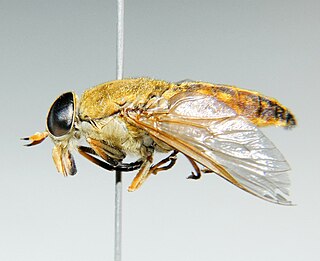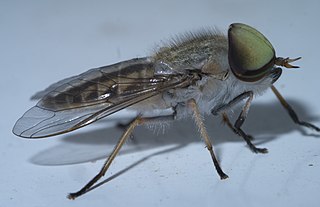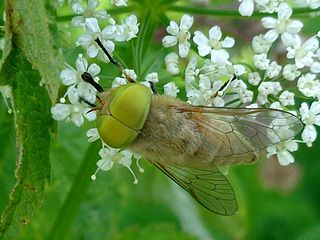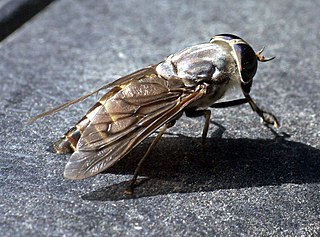
Tabanus nigrovittatus, also known as the greenhead horse fly, salt marsh greenhead, or simply the greenhead fly, greenhead or greenfly, is a species of biting horse-fly commonly found around the coastal marshes and wetlands of the Eastern United States. They are smaller than most horsefly species, instead being close in size to a common housefly. The biting females are a considerable pest to both humans and animals while they seek a source of blood protein to produce additional eggs: greenhead larvae develop in the mud of salt marshes, and adult flies mate and lay their first group of eggs in the marsh, but to lay more eggs a female fly needs to drink an animal's blood, and so female greenheads which have laid eggs fly inland to look for prey in the area bordering the marsh; they can stay on land looking for animals to bite for up to four weeks. Their bites are more painful than those of mosquitoes, since greenheads feed by cutting a wound in the skin with scissor-like mouth parts and sucking the blood released through it. Females live for three to four weeks and may lay about 100 to 200 eggs per blood meal. The eggs are laid on the grass in a salt marsh; the larvae live in the intertidal mud of the salt marsh for one or two years, preying on other invertebrates, before pupating in early spring. The adult flies emerge in late spring and are most common from late June to August.

Tabanus fulvulus is a horse fly in the subfamily Tabaninae, in the order Diptera ("flies").
Tabanus fusconervosus is a horse fly in the subfamily Tabaninae, in the order Diptera ("flies").

Tabaninae is a subfamily in the family Tabanidae commonly known as horse flies. There are more than 3000 described species in Tabaninae.

Tabanini is a tribe of horse and deer flies in the family Tabanidae. There are at least 220 described species in Tabanini.
Tabanus proximus is a species of horse flies in the family Tabanidae.

Atylotus is a genus of horse flies in the family Tabanidae.
Tabanus novaescotiae is a species of Horse-fly in the family Tabanidae.
Tabanus fumipennis is a horse fly in the subfamily Tabaninae, in the order Diptera ("flies").

Tabanus trimaculatus is a species of horse fly in the family Tabanidae.
Tabanus petiolatus is a species of horse fly in the family Tabanidae. Unlike many Tabanus species, the colour pattern of male eyes is found in the larger, upper lenses - appearing as a dark, brown streak across the light coloured lens. Females of this species have uniformly coloured dark brown eyes. Often confused with Tabanus melanocerus or Tabanus trimaculatus.
Hamatabanus carolinensis is a species of horse flies in the family Tabanidae.
Tabanus trijunctus is a species of horse fly in the family Tabanidae.
Tabanus marginalis is a species of horse fly in the family Tabanidae.
Hybomitra frontalis is a species of horse flies in the family Tabanidae.
Tabanus quinquevittatus is a species of horse fly in the family Tabanidae.

Tabanus sulcifrons is a species of horse fly in the family Tabanidae.
Hybomitra rhombica is a species of horse flies in the family Tabanidae.
Hybomitra astuta is a species of horse flies in the family Tabanidae.







